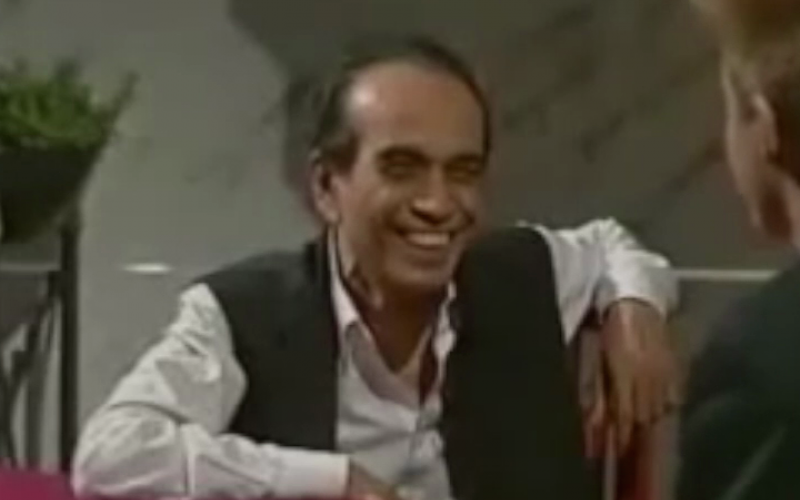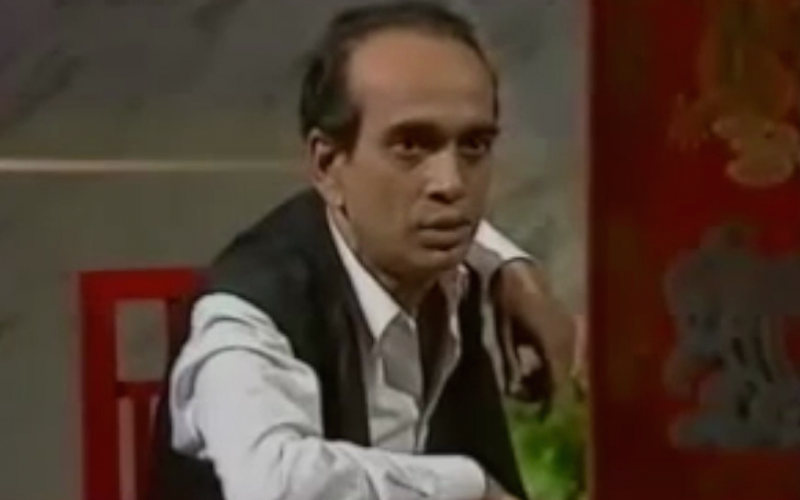Submitted by Jamy Ian Swiss on
Imam
Last week’s Take Two about Slydini brought to mind the wonderful magician, Imam. In my latest book, Preserving Mystery, I include a memorial piece about the Indian-born magician who came to play a key role in the New York City magic world for several decades, from performing at the Magic Towne House in the 1970s and early ‘80s, to owning and operating Mostly Magic from 1980 to 1997, the club that served as the leading performance venue for magic in New York City in its time. Mostly Magic is where I saw Slydini many times for the public on Friday nights, as I mentioned in last week’s installment, and Imam knew Slydini well and was in fact deeply influenced by Slydini’s work.
We don’t have much public video of Imam—I only know of one clip, although it is a very good one. And so in order to provide a bit more thorough background about my subject this week, the following is drawn and adapted from my piece in Preserving Mystery (and which originally appeared as an obituary in M.U.M., the journal of the Society of American Magicians).
Since this first clip is how Imam always opened his close-up shows, I think you should watch this first before we continue. This is a stunning piece of work: a radically original take on what is usually a clownish piece of goofy fluff. In Imam’s hands it becomes something very different. Please do it justice by setting aside the smart phone, turning up the sound, and expanding the browser to the max. Prepare yourself from something truly special and unique: the magic of Imam!
So that’s how Imam began his close-up shows. It was an unforgettable, unprecedented performance piece, simultaneously disturbing and entertaining, terrifying and hilarious. And many in the audience were never quite sure what to make of it, or what they should be feeling. And that was, of course, the idea.
My friend Max Maven has said that magicians are afraid of magic. When he first expressed that thought to me, decades ago, I wasn’t sure I knew what he meant. Now I do. But Imam was not afraid of magic. Instead, he made his audiences feel that fear.
But Imam also made them gasp at magic’s impossibility, and sigh at its beauty. His close-up repertoire included a visual one-coin routine, and a slow-motion piece in which paper balls magical vanished and then mysteriously arrived within a brass Indian goblet—routines inspired by, but quite different from, one of his friends and inspirations, Slydini.
Born in Comilla, a part of India that is now considered Bangladesh, raised in Pakistan, Imam Hossain earned a bachelor’s degree in engineering in his native India, and then migrated to Ontario, Canada in 1965 for an affordable opportunity to continue in graduate school. Completing his studies in 1970, he then migrated to New York City, where he landed a job in structural engineering. He worked on elements of bridge design and construction for much of his career.
More germane to our story, at the age of ten he had the chance to see the performance of a traditional Indian street magician, a “jadoo-wallah.” Imam’s father persuaded the mage to teach Imam a trick, and thus began a lifetime passion for magic. He maintained his interest throughout college years, performing and producing shows on campus. Imam would eventually find an ideal venue for his unique style and approach when he became a regular performer at New York City’s Magic Towne House, Manhattan’s premiere close-up magic venue in the late 1970s and early 80s. The Towne House was owned and operated by the magicians Dick Brooks and Dorothy Dietrich (Dorothy is also an escape artist), and numerous New York City performers had the chance to find encouragement and audiences at the venue, including Imam, Peter Samelson, Wesley James, Peter Kougasian, Peter Maloney, Devlin, Levent, along with veteran performers of the era like Frank Garcia and Earl “Presto” Johnson, and many more.
In 1980, Imam struck out on his own, opening Mostly Magic on Carmine Street in the West Village. The design offered an ideal setting for formal close-up magic, with a comfortable lounging area to the front, a small bar, and then in the rear, a miniature amphitheater with raked seats on three sides. A weekly highlight of the club was the early Friday night show, which featured no less than Slydini himself performing a complete show every week for four or five years. It was a privilege and an education for me, along with so many others, magicians and public alike, to see him there on a regular basis.
There were countless memorable nights spent at Mostly Magic. It was often the setting for magic lectures by the likes of Al Goshman, Johnny Thompson, and Juan Tamariz, among others. And in 1987, NHK television, in cooperation with the last of the New York Magic Symposium conventions, shot two nights of all-star close-up shows, hosted by Max Maven, which became a Japanese TV special. I attended those remarkable nights, including the likes of Tommy Wonder, Gerard Majax, Finn Jon, Eugene Burger, John Carney, and many more.
Eventually Imam, along with his wife and business partner, Evelyn, expanded and rebuilt Mostly Magic, turning the close-up magic theater and lounge into a bar and restaurant with a standup performing area. Early weeknights featured close-up magic, but Friday and Saturday shows now presented standup performers, including not only Magic Towne House veterans (after its eventual closing; Dorothy Dietrich and Dick Brooks now own and operate the Houdini Museum in Scranton, Pennsylvania), but also performers like comedy maestro, “Professor” Bobby Baxter, and the master manipulator, Lou Lancaster, along with musical performers including the blues/folk singer, Guy Davis.
In 1992, when I returned to New York City from Washington, DC, I became the regular Wednesday night bar and close-up performer, and periodically headlined on the weekend shows as well. My first weekend show, my opening act broke a cinder block over his own head, and I was determined to get to know him. His name was Todd Robbins, which began a long friendship and association, leading to our eventual collaboration, along with Michael Chaut, Peter Samelson, and the late Frank Brents, producing New York’s longest-running Off-Broadway magic show, Monday Night Magic (and where Imam once performed on stage), which was created to fill the Manhattan magic void left when Mostly Magic, after a remarkable run of 17 years, eventually closed its doors.
Imam’s own performances were a feature of Mostly Magic’s shows, and his standup repertoire was as distinct and original as was his close-up material. Among other routines, his standup shows featured a wonderful Miser’s Dream, accompanied by one word of script, repeated over and over: “Money!” The approach brought a penetrating truth to the trick’s historical title.
My favorite standup piece was a routine in which a knot slowly crawled up a rope. This dry description does not justice to the small theatrical masterpiece Imam made it, accompanying the slow-motion animation with an evocative story, accompanied by Indian music, about the Indian Rope Trick. “The air was hot, and filled with dust. … Beautiful!”
Imam was little recognized outside the New York magic arena, but his tremendous contribution to the artistic and commercial culture of New York’s magic scene, not only as a performer but also as an encouraging and influential venue operator, was repeatedly noted over the years. In 1977 he received the Slydini Close-up Award from the New York ring of the IBM; in 1989 he was named SAM Parent Assembly Magician of the Year; and in 2002 an emotional tribute to him was featured at the Centenary national S.A.M. convention in New York City. In print, he contributed a series of close-up magic items to the first five issues of Hocus Pocus magazine, circa 1978, published by Brooks and Dietrich of the Magic Towne House; the extensive photo illustrations accompanying the trick descriptions are reminiscent of the Slydini books by Karl Fulves, demonstrating the emotional vibrancy of Imam’s eyes and facial expressions, along with a similarly deep understanding of misdirection. And Imam was featured on the cover of the July/August 1989 issue of Magic Manuscript magazine.
At the conclusion of his program of close-up magic, the Indian magician declared that he would now perform a “bloodless illusion.” He took out a serrated table steak knife and, after carefully cleaning the blade, he positioned the knife over his knee, blade edge pointed upward. Then, gathering his focus and concentration, he paused … whereupon he violently slammed the heal of his hand, like the proverbial “karate chop,” directly down onto the blade. Repeatedly and viciously striking the blade, the claimed bloodless illusion was in fact spraying blood across the upturned blade and the injured hand, struck with such force that the blade actually stuck into the flesh several times and had to be forcibly removed during the few seconds of the outlandish self-targeted attack.
The man threw down the knife and grabbed a cloth to stanch the blood flow, squeezing the wound in pain. Most of the audience was frozen, aghast – but invariably someone would laugh nervously, for want of escape from the strangling tension in the room. “DON’T LAUGH!” the man would scream, his eyes open to the size of twin moons.
And then, after an excruciating, wondrous pause … the handkerchief was withdrawn, the hand was shown intact, healed – bloodless! – and the man turned to the audience, and his face blossomed with a broad, joyous, intelligent smile – like the one we had first been greeted with.
And … applause!
Imam, ladies and gentlemen!
Applause!
Imam Hossain
April 2nd, 1949 – December 30th, 2012
SEE TAKE TWO INDEX









